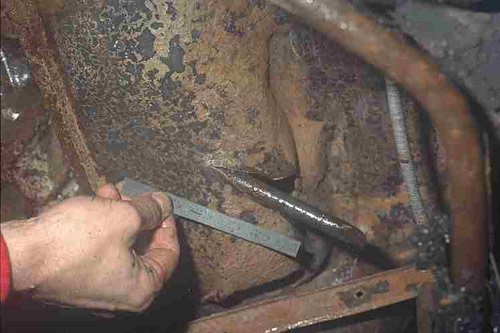|
|
1990 Lincoln Town Car: Case Study Fuels and Ignition
Fuels: Impact to the right-rear resulted in several holes and tears in the gasoline tank. Breaches in the tank were caused by at least two rods, each puncturing both the top and the bottom of the tank. One of the rods was a tire lug wrench still in position through the tank at the time of inspection. The lug wrench induced a 4" tear in the bottom of the tank. There were also tears at folds and seams.
 Tire iron pierced through trunk floor and breached gasoline tank |
Ignition: No definitive physical evidence was found identifying ignition sources. The collision occurred at night and presumably lights of both vehicles were on. Wiring was in the crush zone of the rear of the Town Car and in proximity to the gasoline tank. Since witnesses reported that the fire was immediate, it is also possible that the C20 van was the source of ignition. The van had substantial front-end damage that may have provided electrical sparks, resistance heating, or mechanical sparks from metal-to-metal contact. The Town Car also had fluid leakage from a cracked transmission housing in the forward end of the vehicle. Exhaust system components were located on both sides of the transmission housing. If transmission fluid reached the exhaust system, it may have penetrated gaps in shielding and ignited on the hot surfaces.
 Chevrolet C-20 van, which collided with Lincoln, may have provided a source of ignition |